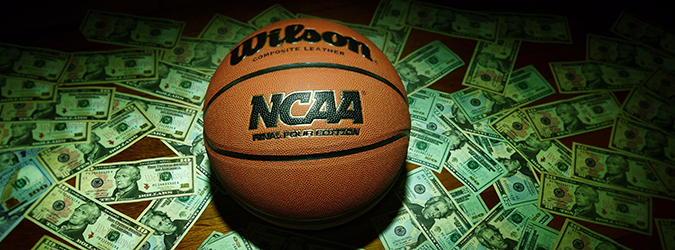The Evolving Landscape of College Student-Athlete Compensation
3.26.2025

The landscape of college athletics continues to change at an unprecedented rate. Name, image and likeness has opened the flow of compensation to student-athletes at all levels. To date, payments for NIL have only been allowed through entities not associated with a university. This rule may change soon as a result of ongoing litigation. The two cases at the center of this evolution are Johnson v. NCAA and House v. NCAA, filed in the U.S. District Court for the Eastern District of Pennsylvania and Northern District of California, respectively. These cases seek to address two fundamental issues: (1) Are student-athletes employees of their respective institutions? (2) Can an institution directly compensate a student-athlete for use of their NIL?
Employment Status (Johnson v. NCAA)
The plaintiffs in Johnson v. NCAA contend that they should be treated as employees, entitled to minimum wage and benefits protections under the Fair Labor Standards Act.[1] The plaintiffs make no distinction among student-athletes, meaning scholarship student-athletes and walk-ons would be treated the same. “Compensation” in the form of monetary value in exchange for a student-athlete’s services is not required under the plaintiff’s theory. To date, no institution has treated student-athletes as employees.
Johnson is the latest effort to define student-athletes as employees and differentiates itself from previous efforts in that a decision in the plaintiffs’ favor could have applicability to both public and private institutions. Previous efforts focused predominantly on student-athletes having the right to unionize and collectively bargain with their private institution by pursuing remedies through the National Labor Relations Board.[2]
Johnson remains in its early stages but has already produced interesting results. In denying the defendant’s motion to dismiss, the district court applied the multifactor test established by Glatt v. Fox Searchlight Pictures, Inc. to determine whether student-athletes “could” be employees under the Fair Labor Standards Act.[3] The defendants appealed, and the case was certified to the Third Circuit for an interlocutory appeal. The Third Circuit determined that (i) student-athletes “could” be employees under the act; (ii) the Glatt test was inappropriate; and (iii) an alternative test should be used to determine employee/employer status in college athletics.[4]
Generally, determination of whether an individual is an employee centers on behavioral control, financial control and relationship details of the arrangement.[5] Proponents for student-athletes being considered employees argue that the degree of control institutions exert over student-athletes and their schedules for training, competition and schoolwork establishes student-athletes as employees. However, the determination that student-athletes can be considered employees of an institution would have far-reaching consequences and lead to several operational and legal questions for institutions. For example:
- The cost to an institution for a student-athlete would grow significantly due to the required benefits under applicable law (e.g., health insurance). Will institutions seek additional funding or seek to cut expenses by eliminating certain sports?
- What laws or policies would govern relationships between student-athletes?
- Would student-athletes enter into a collective bargaining agreement with the institution?
- Can underperforming student-athletes be fired by the institution?
- Can an employer impose certain academic requirements (e.g., 12 hours of study per semester, GPA requirements, etc.) upon an employee?
For institutions that utilize athletics as an enrollment driver, what is the long-term effect of employee status? At this point we only have speculation – however, the added expenses that go along with deeming student-athletes employees is likely to create significant institutional discussions and decisions going forward, especially for schools with net revenues below those of the “Power 5” conference institutions (Big Ten, Southeastern Conference, Big 12, Atlantic Coast Conference and Pac-12).[6] The effect of the added costs could lead to the elimination of certain non-revenue sports or, in some cases, the elimination of an institution’s athletic department.
Direct Payments (House v. NCAA)
Before Johnson is decided, however, House v. NCAA is likely to be settled or resolved, possibly paving the way for direct compensation to be paid from an institution to its student-athletes. The plaintiffs in House allege that NCAA rules violate antitrust laws and are anticompetitive. The plaintiffs allege that the NCAA and the Power 5 conferences conspired to exploit student-athletes and that the NCAA’s prohibitions on NIL activities and control of television markets prevent student-athletes from capitalizing financially off of their participation in collegiate athletic competitions.
The House case was filed in 2021, garnering national attention due to the significant amount of potential damages and transitional impact on college sports. In May 2024, the parties submitted a preliminary settlement agreement to the court for approval. Judge Claudia Wilken returned the preliminary settlement to the parties and requested revisions be made. The amended preliminary settlement (settlement) was submitted on Sept. 26, 2024 and was preliminarily approved by Judge Wilken on Oct. 27, 2024.[7] Preliminary approval of the settlement set in motion a timeline of events to occur in 2025. Interested parties had until Jan. 31 to file objections with the court for consideration prior to the final approval hearing scheduled for April 7. If approval is granted, the structure set forth in the settlement shall go into place for the 2025-26 academic year.[8]
The settlement accomplishes several things. First and foremost, it awards $2.78 billion in back pay to be distributed to class members (former student-athletes). Second, the settlement sets forth a 10-year model for NCAA Division I institutions to utilize future revenues to compensate student-athletes directly for their NIL. The settlement establishes the framework for institutions to directly compensate student-athletes. Each institution will have the right to enter into an exclusive or non-exclusive license and/or endorsement agreement for a student-athlete’s NIL, institutional brand promotion or other rights as permitted by the settlement. The license or agreement shall authorize payments to student-athletes for the right to use a student-athlete’s NIL for a broadcast of collegiate athletics games or events. If an institution “opts in” to the settlement, they will be able to spend up to a maximum 22% of the “average shared revenue” on its student-athletes through direct payments and additional scholarships. Average shared revenue is based on the named defendants’ and the University of Notre Dame’s most recent NCAA membership financial reporting system that shows their athletic media, ticket and sponsorship revenue. For the 2025-26 academic year, that equates to approximately $20.5 million per institution. Payments over this capped amount are not permitted and penalties will be enforced by a to-be-determined entity. The cap amount escalates each year for 10 years. Institutions are not required to spend up to the 22% number – each institution retains the right to determine its own payment amounts, so long as they stay below the applicable cap.[9]
Other Issues Raised by the Settlement
The settlement also sets out a number of changes to longstanding NCAA legislation. The most prominent of these changes, scheduled to enact for the 2025-26 academic year, is the elimination of scholarship limits and the institution of roster limits.[10] Roster limits would establish a maximum number of student-athletes that can be on a given team. Under current NCAA legislation, each sport is limited in the number of scholarships it can provide for its student-athletes (for example, NCAA’s Football Bowl Subdivision colleges are allowed 85 scholarships).[11] There is no cap on how many student-athletes may be on a team’s roster, which leaves spots for non-scholarship athletes to walk on to a team. These walk-on opportunities also help institutions, especially smaller ones, meet their enrollment goals.
Most Football Bowl Subdivision teams carry 125-140 student-athletes on their roster. With roster limits in place, there will be fewer opportunities available to student-athletes to participate at a given school (football will have a roster cap of 105 student-athletes). This change will modify longstanding NCAA financial aid legislation[12] and will have a profound effect on the total number of student-athlete opportunities at a university. Many Power 5 institutions are estimating a reduction in total student-athletes between 80-150 as a result of the roster limits.[13] These student-athletes will either continue their education without playing their sport, or they will have to transfer to another institution.
For NCAA Division I institutions that decide not to opt in to the settlement, the current NCAA rules regarding scholarships will continue.[14] Student-athletes at those institutions may still enter into NIL deals, just not directly with their institution. For example, a student-athlete can promote a business in exchange for a fee or may sign autographs and get paid for the service (standard NIL). What is less clear is the effect of subsequent changes to NCAA legislation in the event the settlement is finalized and approved. The NCAA has said that it will modify its rules to reflect the settlement after final approval.[15] The unknown is whether the revised legislation will apply to all Division I institutions, or whether alternative legislation will remain in place for institutions that have decided not to opt in to the settlement. Will these changes reduce revenue distributions from the NCAA to schools that choose not to opt in? Without any clear guidance on the matter, institutions must weigh the pros and the cons of whether to opt in and to remain nimble while navigating the changing landscape.
The settlement is also (intentionally) silent on the application of Title IX to payments from an institution to the student-athlete. Do the amounts paid directly to men and women student-athletes need to be consistent with Title IX proportionality standards, or they can be appropriated according to some other metric? Title IX states that institutions “must provide reasonable opportunities for members of each sex in proportion to the number of students of each sex participating in . . . intercollegiate athletics.”[16] This standard has applied to athletic scholarships, access to facilities, equipment, coaches, etc. over the years. What is less clear is whether NIL payments fall into this same category, or because an individual’s NIL market value varies based on both the sport and the revenue generated from it, that market share should be utilized to determine compliance with Title IX. Institutions have indicated they intend to distribute payments based upon market value. This analysis is similar to coaches’ salaries paid by an institution. Title IX requires the school to provide equal training and coaching opportunities to its men’s and women’s teams.[17] The cost associated with equal coaching is not part of the analysis; rather, the market dictates the amount to be paid to a coach. Adding to this analysis, the Department of Education recently issued a fact sheet determining NIL payments be treated similar to scholarships.[18] The fact sheet, however, was not precedential or binding and was issued just before the Trump administration took office. On Feb. 12, the guidance was rescinded by the Department of Education. Without any clear guidance, institutions are working with their Title IX attorneys to determine the best way to navigate the settlement.
Conclusion
The past four years have provided landmark changes to collegiate athletics. The creation of NIL and NIL collectives and direct challenges to the NCAA’s authority to govern its member institutions have led many to use the phrase “the Wild Wild West” when describing the current landscape. This trend will continue as Johnson and House are decided and we see the effects on both institutions and student-athletes. The result of each case will lead to additional legal questions and theories. Also unknown is the overall effect these changes will have on the competitive playing field. All of these issues are being considered by institutions and conferences as they determine how to proceed. Regardless of how the cases are decided, additional litigation remains likely unless Congress intervenes to provide some protection for institutions. Efforts thus far have failed to gain traction in Congress, but the subject has been prioritized going forward.[19] One way or another, we know that more changes to the landscape of collegiate athletics are on the horizon.
Kyle Ritchie is senior counsel at Bond, Schoeneck and King and is part of their Collegiate Sports Practice Group. He has significant experience in name, image and likeness matters and assisting institutions through the evolving landscape of college athletics. His familiarity with NCAA legislation and its processes helps assist higher education clients in navigating both current litigation and emerging areas of risk management.
Endnotes:
[1] Johnson v. Nat’l Collegiate Athletic Ass’n, No. 19-5230, 2021 U.S. Dist. LEXIS 273101 (E.D. Pa. 2021).
[2] See NLRB actions involving Dartmouth, University of Southern California and University of Notre Dame, which have been withdrawn.
[3] Johnson v. Nat’l Collegiate Athletic Ass’n, 108 F.4th 163 (3d Cir. 2024).
[4] Id.
[5] See generally IRS Publication 5520 (5-2021).
[6] Power 5 institutions, along with Notre Dame, generate significantly more revenue through their football and men’s basketball programs than other Division I institutions. See Grant Hughes, College Athletics’ 25 Powerhouses Who Produce the Most Revenue Entering 2024, 247 Sports, June 27, 2024, https://247sports.com/longformarticle/college-athletics-25-powerhouses-who-produce-the-most-revenue-entering-2024-233312519/.
[7] House v. Nat’l Collegiate Athletic Ass’n, 4:20-cv-03919, (N.D. Cal. October 27, 2024) Amended Stipulation and Settlement Agreement.
[8] Id.
[9] Id. at Appendix A, pp. 8-17.
[10] Id. at Appendix A, p. 18.
[11] NCAA Bylaw 15.5.3.1 (2024-2025).
[12] Updated Question and Answer: Impact of the Proposed Settlement on Division I Institutions, NCAA, Dec. 9, 2024, https://ncaaorg.s3.amazonaws.com/governance/d1/legislation/2024-25/Dec2024D1Gov_PhaseTwoInstSetQuestionandAnswer.pdf.
[13] Ross Dellenger, Historic House-NCAA Settlement Leaving Hundreds of Olympic Sport Athletes in Peril, Yahoo! Sports, Oct. 25, 2024, https://sports.yahoo.com/historic-house-ncaa-settlement-leaving-hundreds-of-olympic-sport-athletes-in-peril-125238713.html.
[14] Updated Question and Answer, supra note 12.
[15] Id.
[16] 34 C.F.R. § 106.37(c) (2025).
[17] 34 C.F.R. § 106.41 (2025).
[18] Factsheet: Ensuring Equal Opportunity Based on Sex in School Athletic Programs in the Context of Name, Image and Likeness Activities, U.S. Dep’t of Ed., Jan. 16, 2025. https://www.ed.gov/media/document/ocr-factsheet-benefits-student-athletes.
[19] Dan Murphy, Texas Senator Aims To Help NCAA Regulate Athlete Payments, ESPN, Jan. 9, 2025, https://www.espn.com/college-sports/story/_/id/43348934/house-settlement-ncaa-sec-big-ten-nil.




